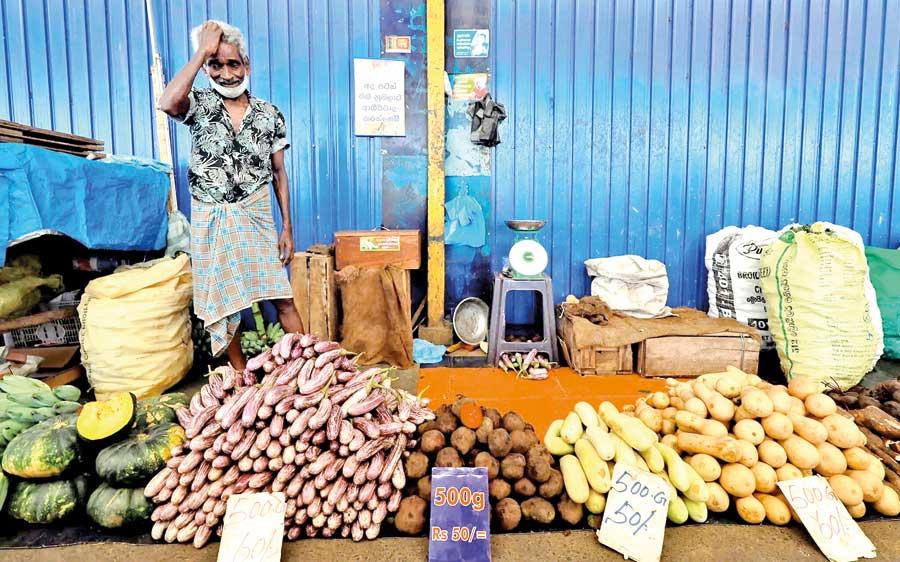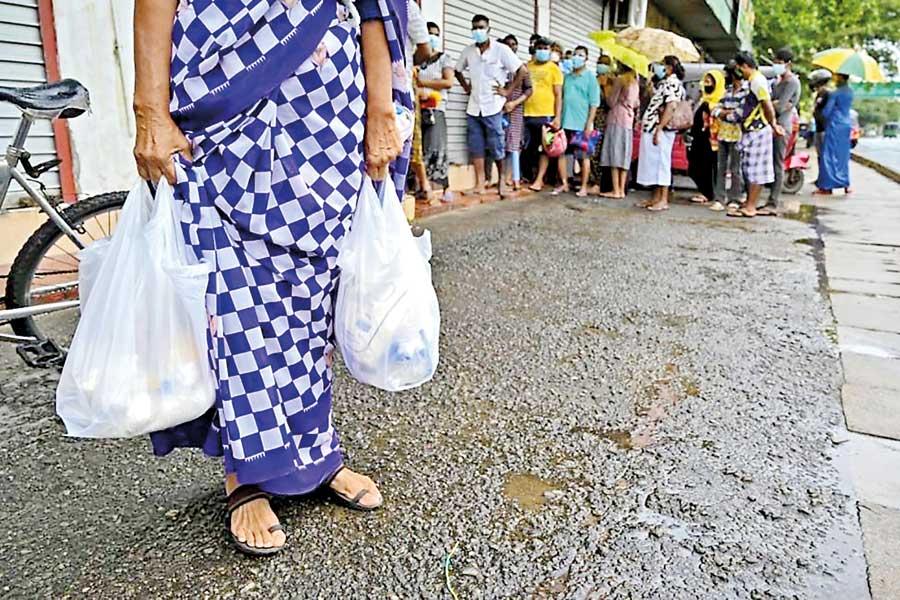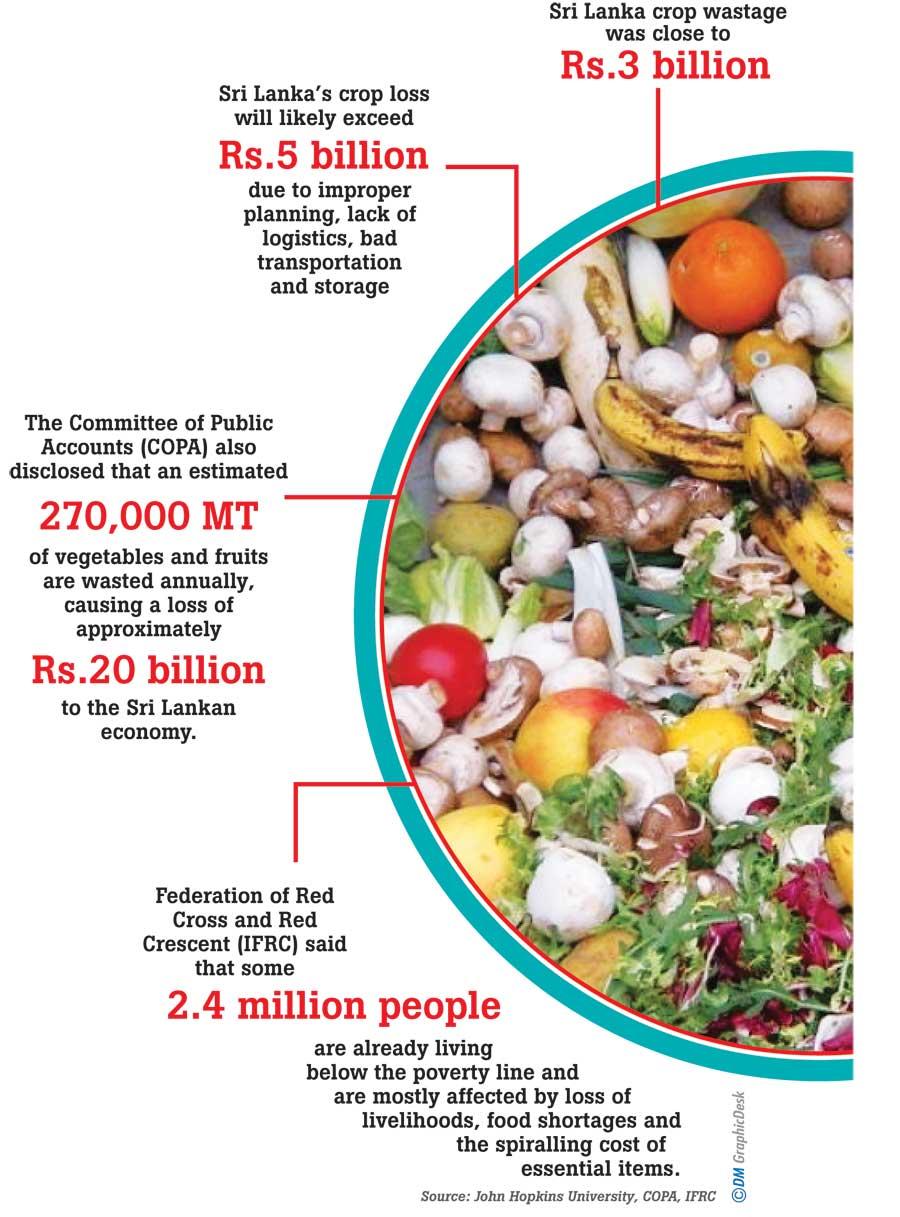Reply To:
Name - Reply Comment

One of the main issues is the lack of a proper system to manage vegetable and fruit produce
Ongoing economic crisis in Sri Lanka has now evolved into a serious humanitarian emergency with food, fuel and cooking gas shortages at the forefront of it
“I sometimes skip breakfast and lunch, so that my other family members can have a wholesome meal,” an undergraduate who wished to remain anonymous said to the Daily Mirror.
undergraduate who wished to remain anonymous said to the Daily Mirror.
“I am a working student and I cover my housing expenses and my monthly tuition fees. Earlier, my salary was enough to buy groceries for a month and save some money at the same time. But in the current situation in the country, due to inflation and changes in prices of daily commodities, it is difficult for me to manage my expenses as it is hard to spend half the salary for the food itself.”
The ongoing economic crisis in Sri Lanka has now evolved into a serious humanitarian emergency with food, fuel and cooking gas shortages at the forefront of it. Being devoid of foreign exchanges and the inability of importing supplies from the global market has also resulted in the collapse of our food structure. The lack of such essentials has caused a major disruption to the system and eventually made the nation fight for its next meal.
Citizens all over the country face daily life with constant uncertainty. Furthermore, some reports indicate that low-income families, specifically, are undergoing starvation. The Sri Lanka Red Cross said that Sri Lanka requires international support to “help hundreds of thousands of people pull their lives back together.”
"Brian Roberts, a professor at the Australia-based University of Canberra, who has researched Sri Lanka’s food supply chain says that produce lost in Sri Lanka is greater than in other countries in the region."
Crop wastage- amplifying the issue
Sri Lanka, however, still has an agriculture-based culture and economy that largely depend on crop exports. Agriculture and farmers are an extremely important part of the economy, so much so, that uplifting the country’s agriculture sector has become one of the primary election promises.
According to John Hopkins University data in 2018 Sri Lanka crop wastage was close to Rs.3 billion. Sri Lanka’s crop loss will likely exceed Rs.5 billion due to improper planning, lack of logistics, and bad transportation and storage. Agriculture wastage is a country-wide issue in Sri Lanka.
The Committee of Public Accounts (COPA) also disclosed that an estimated 270,000 metric tons of vegetables and fruits are wasted annually, causing a loss of approximately Rs.20 billion to the Sri Lankan economy.
The COPA committee pointed out that the farmers are cultivating according to their liking because there is no extensive cultivation plan in place to meet the food demands of Sri Lankans. This is a major blow to Sri Lanka as the citizens are already facing high prices for food items that they manage to get their hands on. The household economy and food security of the country has been severely affected as a result. The International Federation of Red Cross and Red Crescent (IFRC) said that some 2.4 million people are already living below the poverty line and are mostly affected by the loss of livelihoods, food shortages and the spiralling cost of essential items.
According to the All-Island Farmers’ Federation (AIFF), post-harvest produce wastage is an issue that has affected farmers of all areas in Sri Lanka and takes place at all economic centres as well as farms.
One of the main issues is the lack of a proper system to manage vegetable and fruit produce.
Due to the lack of methods to preserve the surplus produce, farmers dispose of it and sometimes economic centres give that produce for animal food, which has been taking place for a long time. This wastage, in turn, affects the consumers, as it is one of the reasons why the prices go up.
"Produce lost in Sri Lanka is greater than in other countries in the region. He stressed that until the public transportation conditions improve, including railways, roads, government- owned trucks and delivery systems, private companies will be the only ones able to afford to cut post-harvest food losses."
Transportation difficulties for crops
The National Audit Office in 2015 estimated that around 30% to 40% of vegetables and fruits get wasted while passing through the supply chain from farm-gate to the consumer.
For the most part, this post-harvest damage transpires because vegetables are still transported in plastic, burlap, locally produced coconut-husk fibre bags or homemade wooden boxes, stacked tightly in trucks, causing severe wastage en route.
“This lack of proper storage reduces the length of time produce can last,” said Brian Roberts, a professor at the Australia-based University of Canberra, who has researched Sri Lanka’s food supply chain.
50-year-old Ajith Wijesinghe said that he had never received any kind of training or instructions on transporting or stacking vegetables in more than two decades of work.
“I don’t think anyone in this business has.”
He added that the more they transport, the more money they earn. Post-harvest damage has been a major issue in the country since the beginning and now with the ongoing fuel crisis, the crop and food transportation and distributions have become even more tedious and disarranged making the difficulties in this procedure worse.
"He stressed that until the public transportation conditions improve, including railways, roads, government-owned trucks and delivery systems, private companies will be the only ones able to afford to cut post-harvest food losses."

How Sri Lanka met this crisis
The food shortage in Sri Lanka is nothing new. Post-harvest damage has been a major issue in the country since the beginning. With poor transportation and all the major odds in the agricultural sector of Sri Lanka, this issue worsened with the Covid-19 pandemic.
The economic crisis which spiralled into a food crisis has particularly impacted food security, agriculture, livelihoods, and access to health services.
Food production in the last harvest season was 40 - 50 per cent lower than last year, and the current agricultural season is at risk, with seeds, fertilizers, fuel and shortages of other essentials. As an outcome of the economic crisis, numerous small businesses have temporarily suspended transactions which made many lose their means of income. It is stated that almost 22 per cent of the population is in immediate need of food assistance. According to surveys, skipping meals, reducing the quantity of every meal and switching to new diet practices are a few common trends that rose due to the current crisis.
A few other reasons that caused the food shortage are:
•The collapse of the food supply chains
•The pause in food imports
•The increase in the prices of essential nutritious and fresh foods (vegetables, fruits, milk, grains and eggs)
"According to John Hopkins University data in 2018 Sri Lanka crop wastage was close to Rs.3 billion. Sri Lanka’s crop loss will likely exceed Rs.5 billion due to improper planning, lack of logistics, and bad transportation and storage. Agriculture wastage is a country-wide issue in Sri Lanka."
Solutions
In order to find ways out of this food shortage, the government urged the public to start planting crops in the home garden which in most cases can be impractical to many people.
“My neighbour’s family has two children and a baby, they are currently running out of rice, they are conserving what they have in store. Now their main meals mostly include potatoes that they grow at home. Yet, they find this an unreliable method as their children lack the necessary nourishment which only goes from healthy diet practices,” the undergraduate said.
Private companies tried to cut down on post-harvest losses by setting up regional buying centres that purchase directly from farmers, buying more trucks and hiring handlers. This also included advising around 10,000 farmers on stacking, transport and quality control. In 2011, the Ministry of Co-operatives and Internal Trade made it mandatory to use plastic crates to transport vegetables and fruits, claiming that this move could save the country around Rs. 20 billion a year. However, farmers and others involved in the agricultural industry protested against this move and continued the use of gunny bags and other methods, paving the way for food wastage. This resulted in the law applying only to a limited number of fruits and vegetables.
Brian Roberts, a professor at the Australia-based University of Canberra, who has researched Sri Lanka’s food supply chain says that produce lost in Sri Lanka is greater than in other countries in the region. He stressed that until the public transportation conditions improve, including railways, roads, government-owned trucks and delivery systems, private companies will be the only ones able to afford to cut post-harvest food losses.
There are significant inefficiencies in the way government supply chains work in Sri Lanka in which most of the infrastructure owned by government facilities is old which undoubtedly causes damage to perishable food. L.P. Rupasena, deputy director of research at the government-run Hector Kobbekaduwa Agrarian Research and Training Institute specified that the country needs a fully integrated market where packing and distribution ensure the delivery of quality goods. He mentioned that we don’t have such a system in place yet.
According to the Food and Agriculture Organisation, less than five per cent of the funding provided during the past few decades for horticultural development worldwide has gone to post-harvest factors.
The rest has gone towards increasing production. Most agriculture-dependent countries need to focus on the reuse of agricultural and agro-industry waste for more economy. It not only increases the economy of local farmers but also the economy of the whole nation.
"According to the All-Island Farmers’ Federation (AIFF), post-harvest produce wastage is an issue that has affected farmers of all areas in Sri Lanka and takes place at all economic centres as well as farms"
